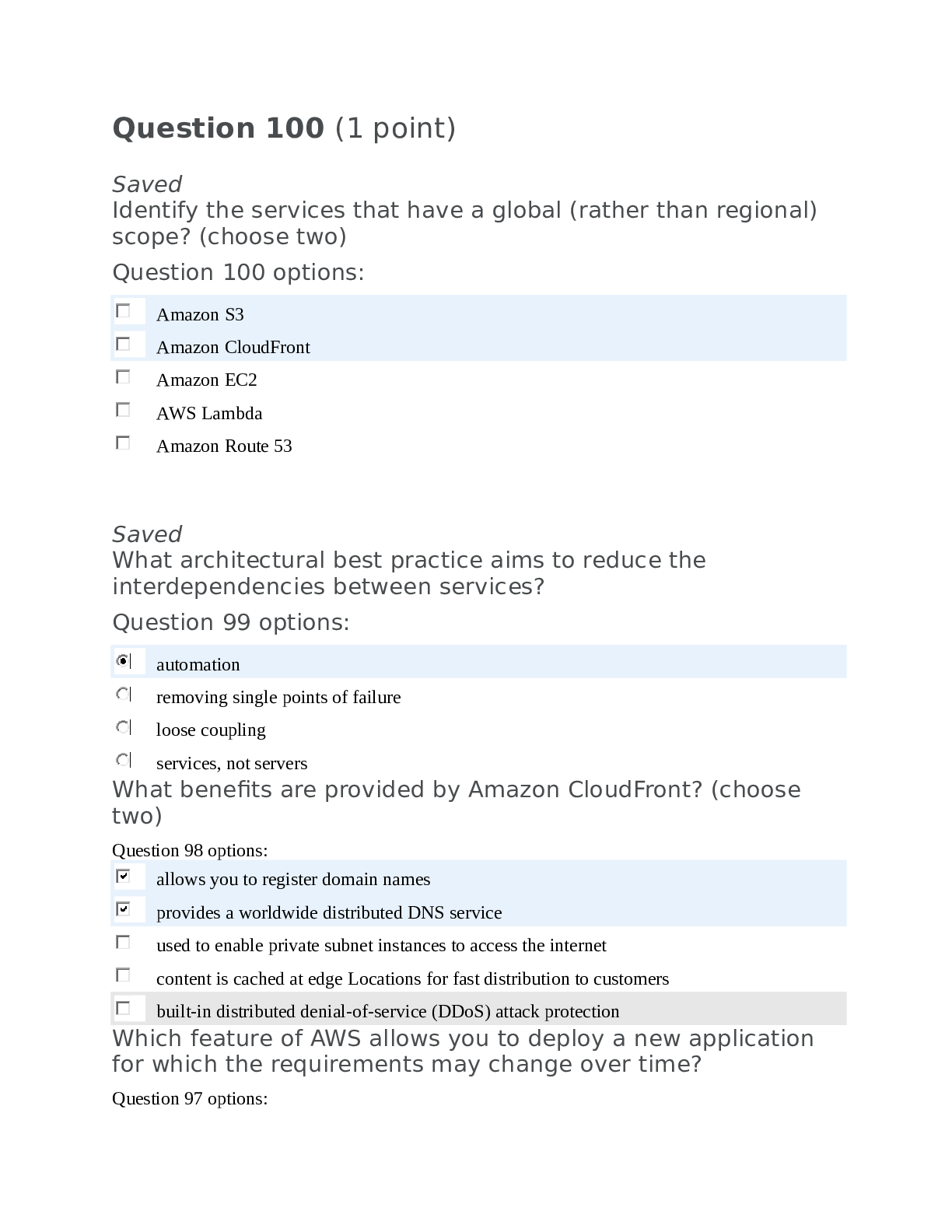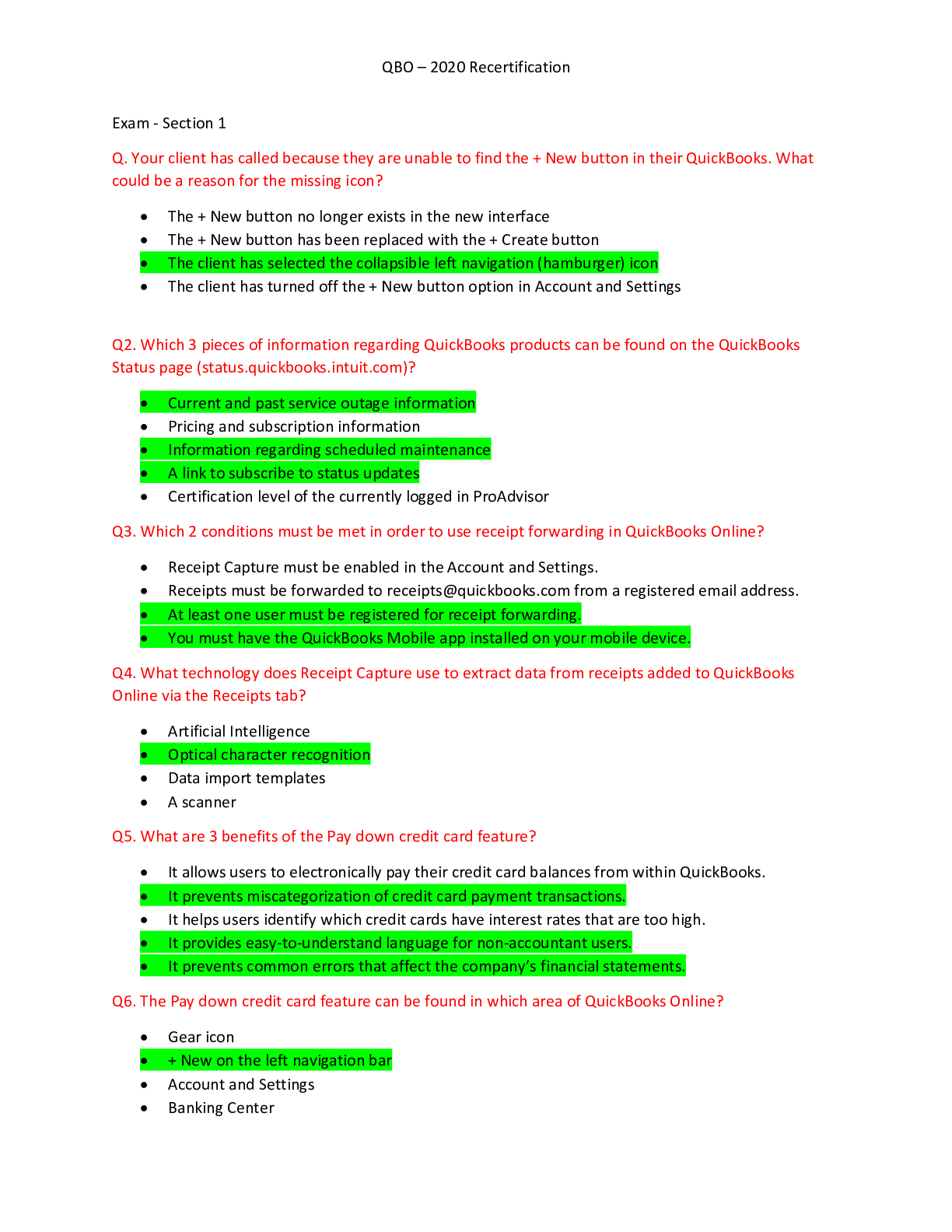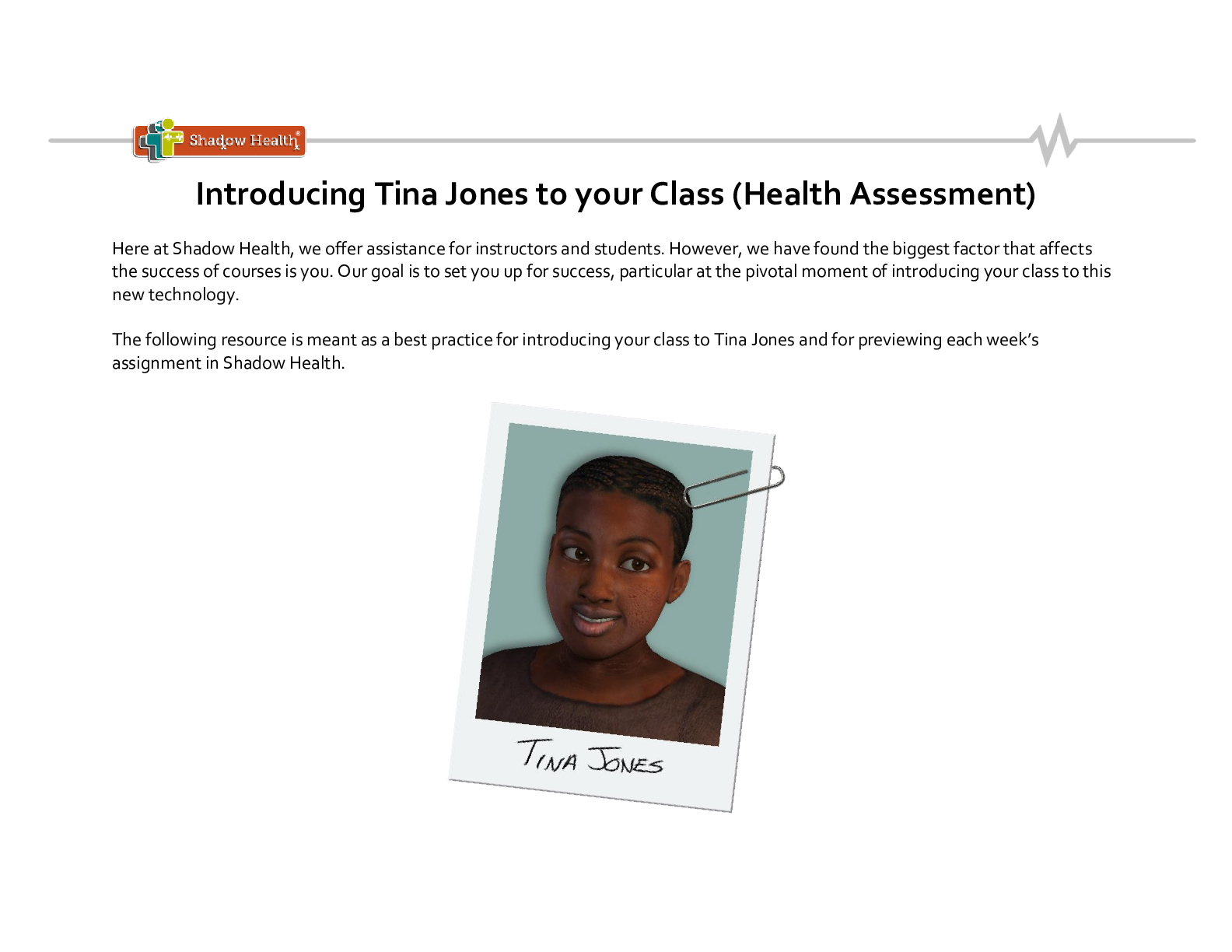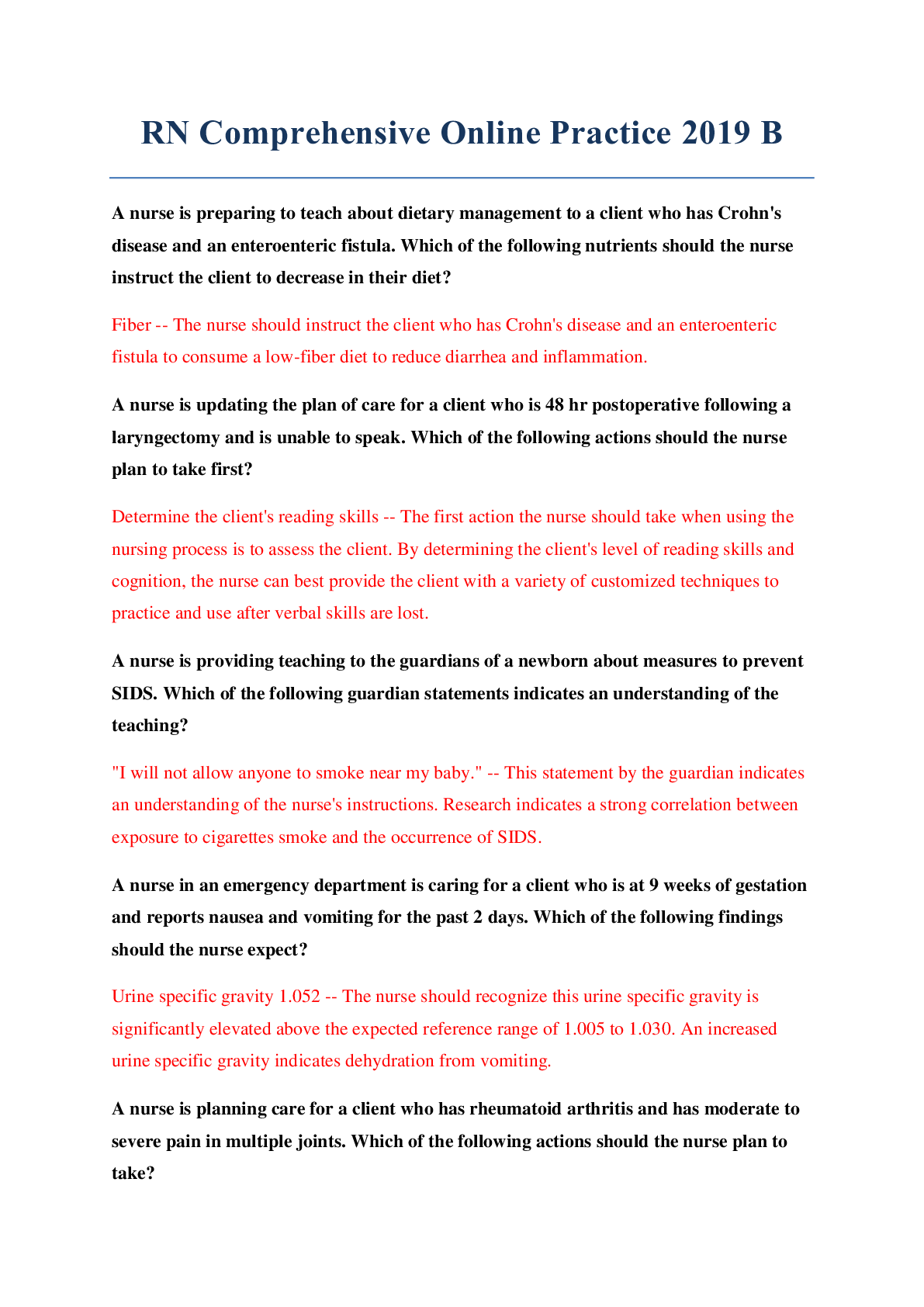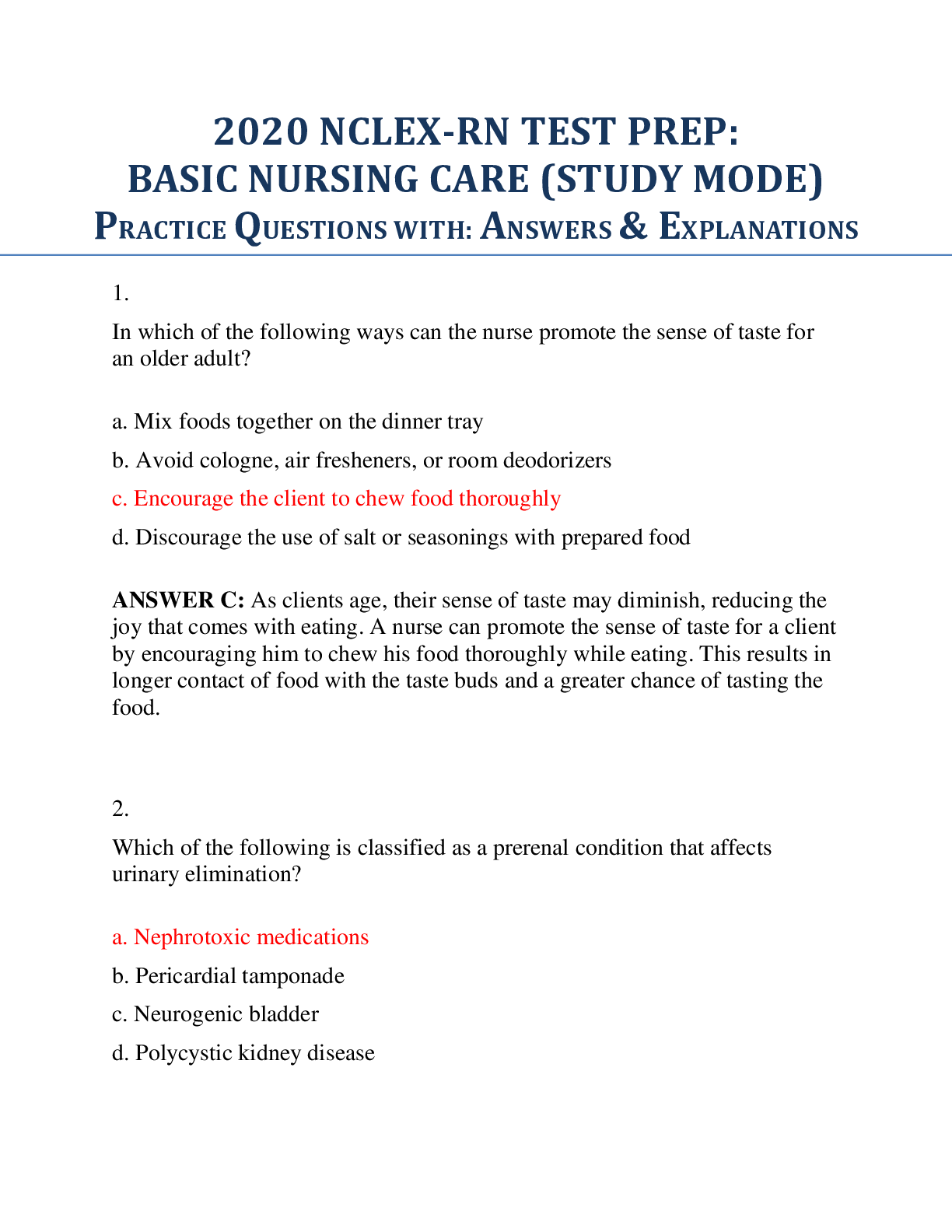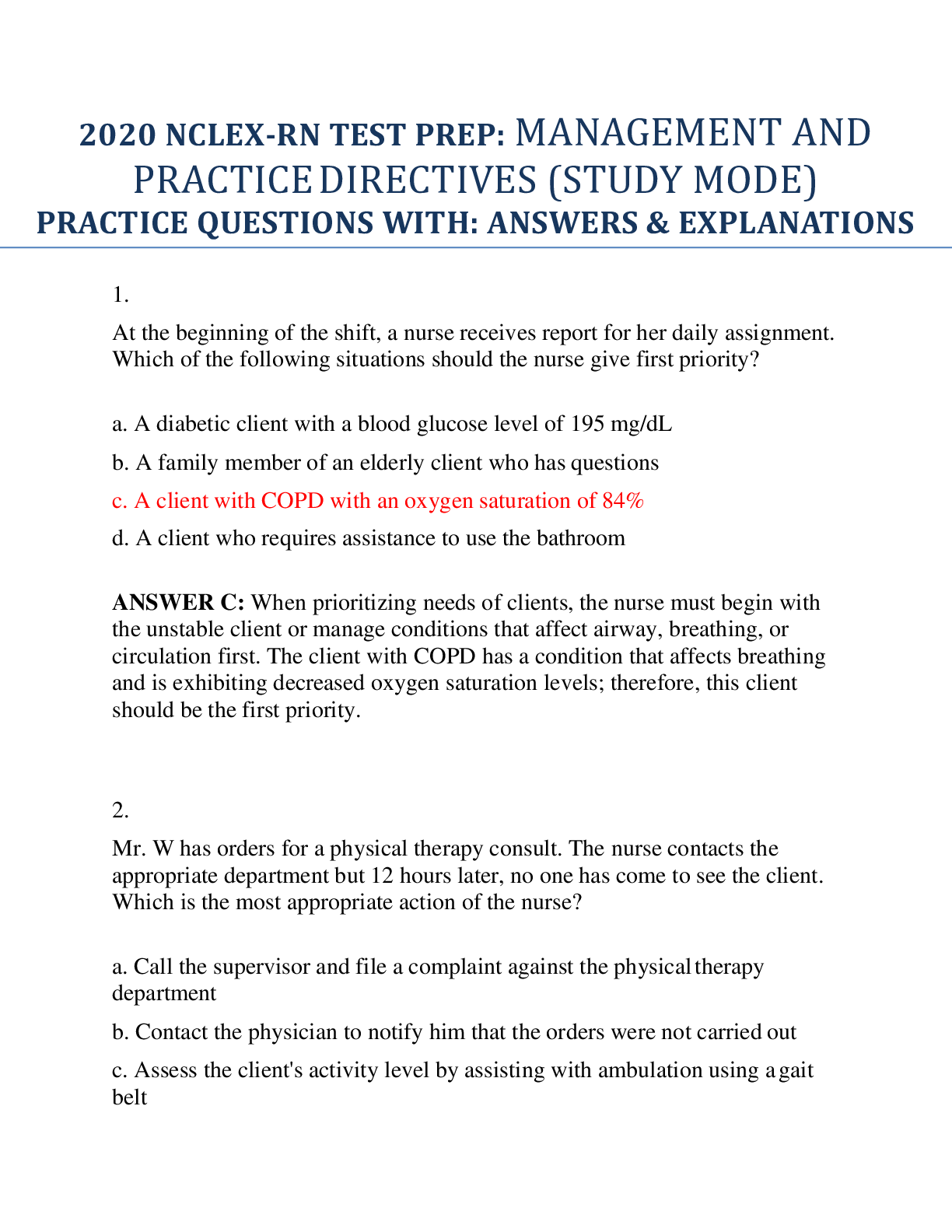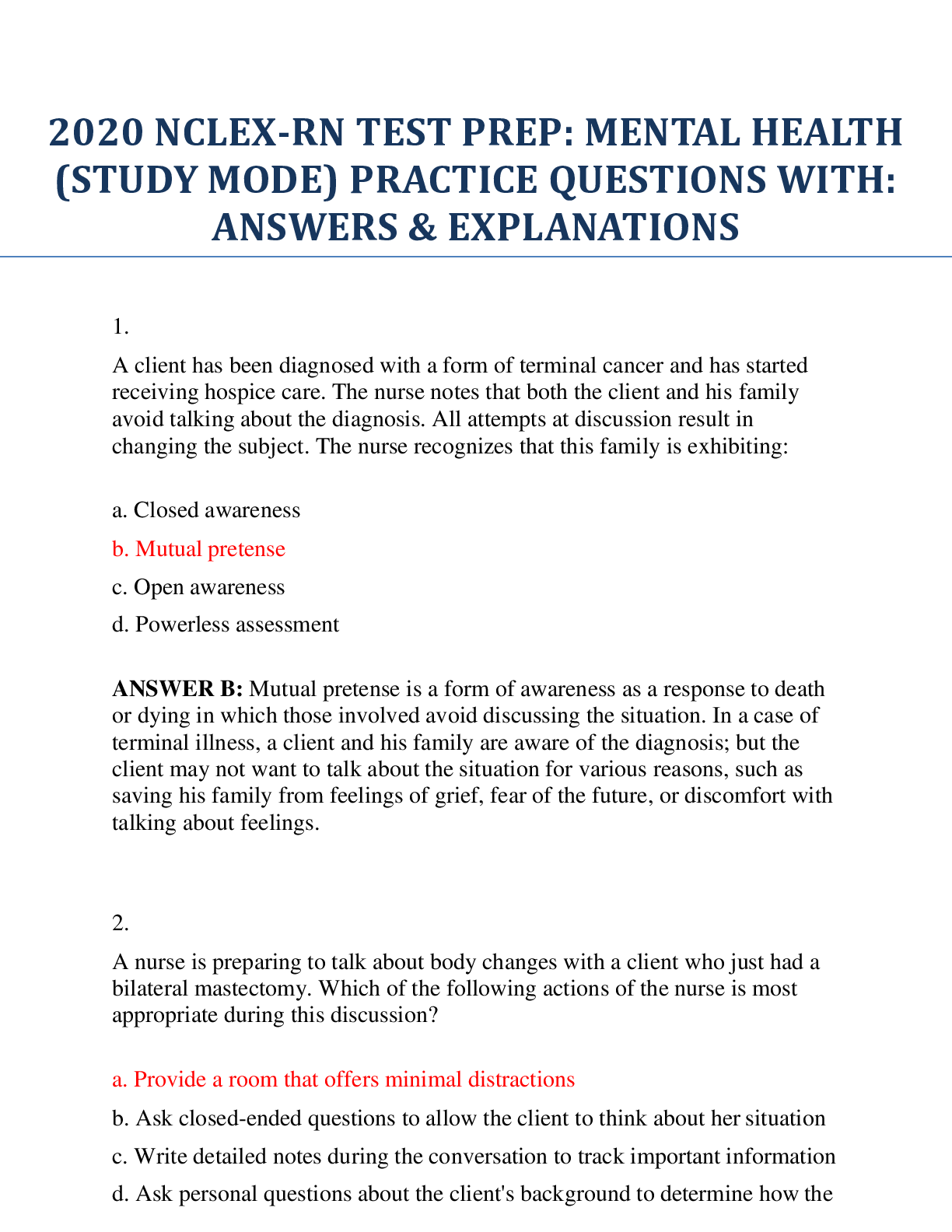*NURSING > EXAM > 2020 NCLEX-RN TEST PREP: PREVENTING RISKS AND COMPLICATIONS (STUDY MODE) PRACTICE QUESTIONS WITH: AN (All)
2020 NCLEX-RN TEST PREP: PREVENTING RISKS AND COMPLICATIONS (STUDY MODE) PRACTICE QUESTIONS WITH: ANSWERS & EXPLANATIONS
Document Content and Description Below
PREVENTING RISKS AND COMPLICATIONS (TEST MODE) 1. Which of the following nursing interventions is appropriate for a client who is suffering from a fever? a. Avoid giving the client food b. Inc... rease the client's fluid volume c. Provide oxygen d. All answers are correct 2. A client has started sweating profusely due to intense heat. His overall fluid volume is low and he has developed electrolyte imbalance. This client is most likely suffering from: a. Malignant hyperthermia b. Heat exhaustion c. Heat stroke d. Heat cramps 3. A nurse is attempting to assess a client's pulse in his foot. She palpates the pulse on the anterior aspect of his ankle, below the lower end of the medial malleolus. Which type of pulse is this nurse taking? a. Dorsalis pedis b. Popliteal c. Posterior tibial d. Femoral 4. Which of the following conditions may cause an increased respiratory rate? a. Stooped posture b. Narcotic analgesics c. Injury to the brain stem d. Anemia 5. Mr. N is a client who entered the hospital with a diagnosis of diabetic ketoacidosis. The nurse enters his room to check his vital signs and finds him breathing at a rate of 32 times per minute; his respirations are deep and regular. Which type of respiratory pattern is Mr. N most likely exhibiting? a. Kussmaul respirations b. Cheyne-Stokes respirations c. Biot's respirations d. Cluster breathing 6. A nurse is attempting to check a blood pressure on a client when she realizes that the cuff is too wide for the size of his arm. What type of reading might this blood pressure cuff produce? a. A normal result b. An abnormally low reading c. An abnormally high reading d. A low reading, followed by a normal reading 7. Which of the following is a true statement about assessing blood pressure by palpation? a. Only the diastolic blood pressure can be assessed through palpation. b. The palpation technique is most useful for infants and small children. c. Hypertension is a common condition that might need to be assessed through blood pressure palpation. d. Only the systolic blood pressure can be assessed through palpation. 8. A nurse is caring for a client who has just come from surgery and is in the recovery room. The client still has an endotracheal tube in place. The nurse deflates the cuff on the tube and pulls it out, at which time the client sits up in bed, grasps his throat, and begins to make wheezing sounds. Which of the following conditions is the most likely cause of this situation? a. The client is choking on part of the tube b. The client has anxiety c. The client is having a laryngospasm d. The client is having a normal response from anesthesia 9. A client with adrenal insufficiency has a potassium level of 7.2 mEq/L. Which of the following signs or symptoms might the client exhibit with this result? a. Peaked T waves on the ECG b. Muscle spasms c. Constipation d. A prominent U wave on the ECG 10. A nurse is assisting Mrs. K, a client who is undergoing a lumbar puncture. Which of the following elements should the nurse use to instruct Mrs. K about this procedure? a. A lumbar puncture takes a sample of blood from the back, which will be analyzed by the lab b. The physician will insert a needle at the level of L4-L5 in the spinal cord c. Mrs. K should lie flat on her back for 24 hours following the procedure d. The risks of the procedure include nausea, rash, and hypotension 11. A nurse is caring for a client who has a right-sided chest tube. The chest tube shows 50 cc of serosanguinous fluid in the collection chamber and air bubbles are collecting in the water seal chamber. Which action is most appropriate of the nurse at this time? a. Do nothing; this is a normal response b. Strip the tubing to remove any clots c. Place a clamp on the tube near the client's chest d. Remove the collection chamber and connect the tubing to a new device 12. A nurse is caring for a client with a broken femur who is in a traction splint in bed. All of the following interventions are part of care of this client EXCEPT: a. Palpating the temperature of both feet b. Evaluating pulses bilaterally c. Turning the client to a side-lying position d. Relieving heel pressure by placing a pillow under the foot 13. A nurse is assessing a client with right-sided heart failure. Which of the following symptoms would the nurse most likely see in this client? a. Weight loss and vomiting b. Coughing and 3+ pitting edema c. Muscle cramps and hyperreflexia d. Lethargy and paroxysmal nocturnal dyspnea 14. A nurse is caring for a client who is post-op day #1 after a total hip replacement. Although the client was alert with a normal affect in the morning, by lunchtime, the nurse notes the client is confused, has slurred speech and is having trouble with her balance. Her blood glucose level is 48 mg/dl. What is the next action of the nurse? a. Contact the physician immediately b. Administer a bolus of 50 cc of D20W through the IV c. Administer 10 units of regular insulin d. Give the client 6 oz. of orange juice 15. A nurse is educating a client about her cholesterol. Which of the following statements from the client indicates the need for further teaching? a. I would like my HDL levels to be over 50." b. It is better for me to have high HDL levels and low LDL levels." c. It is better for me to have high LDL levels and low HDL levels." d. My goal is to get my total cholesterol down below 200." 16. A nurse is preparing to draw a blood specimen from an adult client's central line. All of the following actions for this procedure are correct EXCEPT: a. Disconnect the current infusion b. Clean the cap with alcohol and attach a 5 cc syringe c. Draw 5 cc of a blood sample to discard d. Flush with saline after the sample 17. Which of the following situations might warrant a laboratory magnesium level? a. Hyperthyroidism b. Arthritis c. Ulcerative colitis d. Depression 18. Mr. G has been admitted to the hospital with a head injury after a 12-foot fall. Which of the following nursing interventions is most appropriate when monitoring intracranial pressure? a. Administer hypotonic solutions b. Keep the head of the bed flat c. Increase the client's core body temperature to 99.9 degrees d. Administer corticosteroids as ordered 19. A nurse is assessing a client's pulse oximetry on the surgical unit. As part of routine interventions, the nurse turns off the exam light over the client's bed. Which of the following best describes the rationale for this intervention? a. External light sources may cause falsely high oximetry values b. A bright light in the client's face may cause a low pulse oximetry c. External light sources may cause falsely low oximetry values d. The client needs a dark and quiet room to recover and maintain proper oxygenation 20. A nurse is educating a client who is preparing to give a stool sample for occult blood. All of the following information is part of teaching for this client EXCEPT: a. Avoid eating red meat for 3 days before the test b. Collect the stool from the toilet after having a bowel movement c. The stool does not need to be kept in a container with preservative d. A small part of the stool from two areas will be tested using a smear 21. A nurse is caring for a 3-day old infant who needs an exchange transfusion. Which of the following statements is appropriate for teaching the child's parents about this procedure? a. The registered nurse will be performing the procedure. b. The procedure takes approximately 1 ½ hours. c. The nurse will draw out 250cc of blood and then immediately replace it with 250cc. d. The infant will continue to receive phototherapy during the procedure. 22. Which of the following interventions is necessary before insertion of an arterial line into the radial artery? a. Ensure that the client does not need surgery b. Assess the client's grip strength c. Perform an Allen test d. Check a serum potassium level 23. A client with asthma is being admitted for breathing difficulties. His arterial blood gas results are pH 7.26, PCO2 49, PaO2 90, and HCO3- 21. Which of the following best describes this condition? a. Uncompensated respiratory acidosis b. Compensated respiratory alkalosis c. Uncompensated metabolic acidosis d. Compensated metabolic alkalosis 24. Mrs. M has had diabetes for seven years. She has worked hard to control her blood glucose levels and watch her dietary intake. Her physician orders a hemoglobin A1C test. Which of the following best describes the action of this test? a. The test determines if the client is anemic and needs iron supplements b. The test determines if there is excess glucose building up in the urine c. The test determines the amount of hemoglobin reaching the liver to support gluconeogenesis d. The test determines the amount of hemoglobin that is coated with glucose 25. Mrs. O is seen for follow-up after an episode of acute pancreatitis. Her physician orders a serum amylase level and the result is 200 U/L. Which of the following is a potential cause of this result? a. The client is pregnant b. The client has hypertension c. The client is in renal failure d. The client has pancreatitis 26. Which of the following conditions increases a client's risk of aspiration of stomach contents? a. A client has a scaphoid abdomen b. A client is in restraints c. A client is lying prone d. More than one answer is correct 27. A nurse is monitoring a client for decreased tissue perfusion and increased risk of skin breakdown. Which measure best improves tissue perfusion in this client? a. Massaging the reddened areas b. Performing range of motion exercises c. Administering antithrombolytics as ordered d. Feeding the client a high-carbohydrate diet 28. Which of the following situations warrants a measurement for orthostatic hypotension? a. A 36-year old male with a spinal injury b. An 86-year old female with significantly altered mental status c. A 58-year old female with near-syncope d. A 41-year old male with acute deep vein thrombosis 29. A nurse is assisting a pregnant client who is having an amniocentesis. Which of the following statements by the nurse indicates the correct teaching for this procedure? a. I'm going to help you lie flat on your back for this." b. Don't worry, I'm sure everything will be all right." c. I will need to help you remove your shirt for this procedure." d. Now that the procedure is finished, I will put a small bandage over the puncture site." 30. A nurse is caring for a client in who is in labor. The nurse has attached an electronic fetal monitor to the client's abdomen and is assessing the baby's heart rate. She notes that the baby's heart rate seems to slow down during each contraction. The heart rate does not return to normal limits until after the contraction is complete. Which type of fetal heart rate change does this pattern describe? a. Variable decelerations b. Late decelerations c. Early decelerations d. Accelerations 31. Which of the following reasons indicates a need for a non-stress test in a pregnant client? a. The client is overdue b. The baby has not been moving c. The mother is carrying twins d. All answers are correct 32. A nurse is caring for a client who has a sodium level of 126 mEq/L. Which of the following symptoms should the nurse expect to see with this client? a. Nystagmus b. Orthostatic hypotension c. Hallucinations d. Dry skin 33. A 58-year old client is being tested for rheumatoid arthritis. Her physician orders an erythrocyte sedimentation rate (ESR). Which of the following results is most likely to be associated with arthritis? a. 5 mm/hr b. 12 mm/hr c. 28 mm/hr d. 40 mm/hr 34. A nurse is caring for an 83-year old man who has had swallowing difficulties. All of the following interventions are appropriate for this client EXCEPT: a. Keep the client in an upright position at all times b. Auscultate lung sounds every shift and after feedings c. Maintain suction equipment at the client's bedside d. Instruct the client about how to perform swallowing exercises 35. Which of the following statements best describes compartment syndrome? a. An injury causes pain and tingling that starts in the buttock and travels down the leg b. An injury causes swelling within muscle tissue that leads to anoxia of nerves and muscles c. An injury causes permanent flexion of the interphalangeal joint, resulting in deformity d. An injury causes pain and swelling of the median plantar nerve 36. A nurse is preparing to insert an indwelling catheter in a female client. Which of the following positions of the client is most appropriate for this procedure? a. Lithotomy position b. Prone position c. Dorsal recumbent position d. High Fowler's position 37. Mrs. G is seen for follow-up after testing for chronically high blood glucose levels. Her physician diagnoses her with type 1 diabetes. Which of the following information is part of this client's education about this condition? a. Type 1 diabetes occurs from increased carbohydrate intake and decreased exercise b. Type 1 diabetes is treated through diet and exercise c. Type 1 diabetes occurs from destruction of beta cells in the pancreas d. Type 1 diabetes results in the cells rejecting the body's insulin 38. A client is preparing to undergo a cystoscopy for stones. Which of the following statements indicates that the client understands the procedure? a. I better drink a lot of fluid now because I won't be able to after the test." b. I will probably see a little blood when I urinate." c. I will be able to go home after 3 days in the hospital." d. I won't need any pain medicine; this probably will not hurt." 39. Which of the following conditions may warrant a serum creatinine level? a. Rhabdomyolysis b. Digitalis toxicity c. Glomerulonephritis d. All answers are correct 40. Which nursing intervention is most appropriate to maintain the patency of a client's nasogastric tube? a. Maintain constant connection to low-intermittent suction b. Irrigate the tube as per physician order c. Suction the mouth and nose every shift d. Perform a daily fecal occult blood sample 41. A nurse is caring for a client who is having blood tests and who has an elevated lymphocyte level. Based on knowledge of cellular components, the nurse knows that these cells: a. Contain histamine and provide protection during allergic reactions b. Are involved in phagocytosis c. Provide protection and immunity against foreign substances d. Carry hemoglobin and oxygen to body tissues 42. Mrs. F has been diagnosed with hyperparathyroidism. Which of the following complications is Mrs. F at highest risk of developing? a. Hyponatremia b. Hypocalcemia c. Hypermagnesemia d. Hypercalcemia 43. Mr. Y had surgery two days ago and is recovering on the surgical unit of the hospital. Just before lunch, he develops chest pain and difficulties with breathing. His respiratory rate is 32/minute, his temperature is 100.8, and he has rales on auscultation. Which of the following nursing interventions is most appropriate in this situation? a. Place the client in the Trendelenburg position b. Contact the physician for an order or antibiotics c. Administer oxygen therapy d. Decrease his IV rate 44. A client has entered disseminated intravascular coagulation (DIC) after becoming extremely ill after surgery. Which of the following laboratory findings would the nurse expect to see with this client? a. Elevated fibrinogen level b. Prolonged PT c. Elevated platelet count d. Depressed d-dimer level 45. A client returns from surgery after having a colon resection. The nurse is performing his assessment and notes the wound edges have separated. This condition is called: a. Evisceration b. Hematoma c. Dehiscence d. Granulation 46. The OR nursing staff are preparing a client for a surgical procedure. The anesthesiologist has given the client medications and the client has entered the induction stage of anesthesia. The nursing staff can expect which of the following symptoms and activities from the client during this time? a. Irregular breathing patterns b. Minimal heartbeat, dilated pupils c. Relaxed muscles, regular breathing, constricted pupils d. Euphoria, drowsiness, dizziness 47. A physician has administered ketamine to a client who is preparing to undergo general anesthesia. Which of the following side effects should the nurse monitor for in this client? a. Delirium b. Muscle rigidity c. Hypotension d. Pinpoint rash 48. A nurse is caring for a client who must use a non-rebreathing oxygen mask. Which of the following statements is true regarding this type of mask? a. A non-rebreather can provide an FiO2 of 40%. b. A client should breathe through his mouth when using a non-rebreather. c. A non-rebreather offers a reservoir from which the client inhales. d. The mask of a non-rebreather should be changed every 3 hours. 49. A client is admitted to a nursing unit with a remittent fever. Which statement best describes this pattern of fever? a. A persistent fever that has lasted over 24 hours b. A fever that lasts 2 days followed by normal temperature for 2 days, followed by fever again c. A fever that lasts 2 days followed by normal temperature for 12 hours, followed by fever again d. A fever that spikes and then lowers without returning to normal 50. Which of the following components is associated with hypertonic dehydration? a. Plasma sodium levels between 130 and 150 mEq/L b. Fluid moves from extracellular space to intracellular space c. Water loss is greater than electrolyte loss d. Physical signs and symptoms are grossly apparent 51. Hepatitis C virus (HCV) can be spread through hugging, sneezing, coughing, sharing eating utensils and other forms of casual contact. a. True b. False 52. The primary route of transmission of MRSA is via: a. Shared needles b. Hands of healthcare workers c. Items in the healthcare environment d. Blood transfusions 53. The key to the prevention of a pandemic influenza is: a. Early detection. b. Early antibiotic treatment. c. Vaccination of at risk populations. d. Isolation of suspected cases. 54. Your patient has been diagnosed with herpes simplex virus 2. Which of the following would NOT be included in your teaching of this patient? a. If you have symptoms, you should avoid sexual contact with other individuals. b. With treatment, this condition can be cured. c. This disease is highly contagious. d. You may experience tingling in the skin before an active outbreak occurs. 55. Sinusitis is caused by a: a. Bacteria b. Fungus c. Virus d. Any of the above 56. Your patient has been diagnosed with a left ankle sprain. On the discharge instructions, the physician has prescribed the RICE protocol. This acronym stands for: a. Rest, Ice, Compression, Elevation b. Radiology, Ice, Compression, Elevation c. Rest, Ice, Cast, Elevation d. Radiology, Ice, Cast, Elevation 57. Which risk factor places patients and residents at the greatest risk for falls? a. Old age b. Middle years c. Pneumonia d. COPD 58. You are taking care of Mary Eden. She is an elderly and frail 91 year old resident. She gets confused during evening hours and at times she thinks that she hears her daughter calling her from the other side of the nursing home. Which physical problem places Mary Eden at risk for falls? a. Her confusion b. Her daughter c. Evening hours d. Her frailness 59. What kind of preventive measures is MOST likely to be used to prevent Mary Eden from falling because of her muscular frailness? a. Physical therapy for muscle strengthening exercises b. Physical therapy for range of motion exercises c. Occupational therapy to help her with confusion d. Medications in order to have her sleep more 60. Tommy R., your 68 year old patient, is at risk for falls. He has fallen 3 times in the last month. You should keep Tommy's in order to prevent him from falling again. a. bed side rails up at all times b. bed in the low position c. call bell within reach d. family members in the room at all time 61. You will be escorting a patient to the operating room on a stretcher. In order to prevent this patient from falling, you must do which of the following? a. make sure the locks are not locked as you move the patient onto the stretcher from the bed b. use a safety belt or strap on the patient throughout their escort to the operating room c. put the bed in low position as you move the patient onto the stretcher from the bed d. All answers are correct 62. Albert B. is incontinent of urine. He also wears glasses and hearing aids. His lead(s) to his risk for falls. a. incontinence and loss of vision b. loss of vision c. incontinence d. loss of hearing 63. All hospitals and nursing homes are mandated to have the goal of a restraint free environment. The best way to achieve this goal is to . a. ban the use of all restraints under all circumstances. b. limit restraints to only those situations when falls cannot be prevented. c. keep all bed side rails up for all patients during the nighttime hours. d. use no skid socks and sheets to prevent falls from chairs. 64. Which of these devices is considered a protective device, rather than a restraint? a. A mitten on the hands to prevent scratching b. A mitten on the hands so the person cannot pull their IV out c. A side rail to prevent the patient from falling d. A soft wrist restraint to prevent the patient from pulling their IV tubing 65. Mr. Freeman has difficulty getting out of bed. The nurse should encourage Mr. Freeman to . a. ask for assistance before getting out of the bed. b. remain in bed because it is safer and he will not fall. c. instruct him to stand up quickly from the bed. d. lean forward and push up and off the bed. 66. Restraints are sometimes used for what patient conditions or situations? a. Punishment when the patient is uncontrollable b. To prevent the patient from pulling their IV out c. When a patient is a danger to self and others d. Both b and c 67. The chain of infection includes the . a. germ, agent, reservoir, exit portal, mode of transmission, entry port, and susceptible host b. active natural, active artificial, passive natural and passive artificial c. opportunism, weakness, immunity, and colonization d. intrinsic, extrinsic, internal and external transmission 68. Asepsis is defined as . a. the absence of all microorganisms b. the absence of disease causing germs c. a urinary infection d. a pathogenic infection 69. Mary T. was admitted to a nursing home on May 1st. On July 4th, she was diagnosed with a skin infection. This infection is considered a infection. a. nosocomial b. systemic c. resident flora d. resident aura 70. A local sign of infection is which of the following? a. Swelling. b. Rapid pulse. c. Fever. d. High white blood count. 71. A systemic sign of infection is . a. swelling b. redness c. heat d. a lack of appetite 72. Mobility is an important human function. The hazards of immobility lead to many physical problems and emotional problems. Immobility can lead to detrimental cardiac, muscular, respiratory, skeletal, urinary, gastrointestinal, skin and emotional changes. Which of the following is an example of a skeletal hazard of immobility? a. Contractures. b. Constipation. c. Calcium loss. d. Catabolism. 73. Which is a physical, integumentary risk among the elderly population? a. Skin tears b. Thickened skin c. Thinning toe nails d. Less nasal hair 74. Elderly patients are more prone to dehydration than younger people because the elderly . a. drink more coffee and tea b. have more stomach mucus production c. have more saliva d. have less sense of thirst 75. You are turning your patient in bed and you see that this confused and lethargic patient had loose car keys and lipstick in the bed and had been lying on them. What is this person at risk for because of all three of these factors: the confusion, lethargy and items in the bed? a. Falls b. Skin breakdown c. Apnea d. Lack of mobility 76. Select the age group that is coupled with an infectious disease that is most common in this age group. a. Infants: High billirubin b. Pre-School and School Age Children: Shingles c. Young Adults and Teenagers: Sexually transmitted diseases d. The Elderly: Malaria 77. A complication of osteoporosis is . a. rheumatoid arthritis b. gouty arthritis c. dorsal flexion d. joint deformity 78. One of the complications of complete bed rest and immobility is which of the following? a. Plantar flexion. b. Dorsal flexion c. Extension contractures d. Adduction contractures 79. Plantar flexion can be prevented with . a. foot soaks b. foot boards c. toe nail care d. proper shoes 80. Alzheimer's disease patients wander. The dangers associated with this wandering can be prevented with which of the following? a. Bed alarms b. Chair alarms c. Door alarms d. All answers are correct 81. The smallest of the white blood cells which also can be involved in humoral immunity is the: a. Lymphocyte b. Monocyte c. Basophil d. Erythrocyte [Show More]
Last updated: 1 year ago
Preview 1 out of 43 pages
Instant download
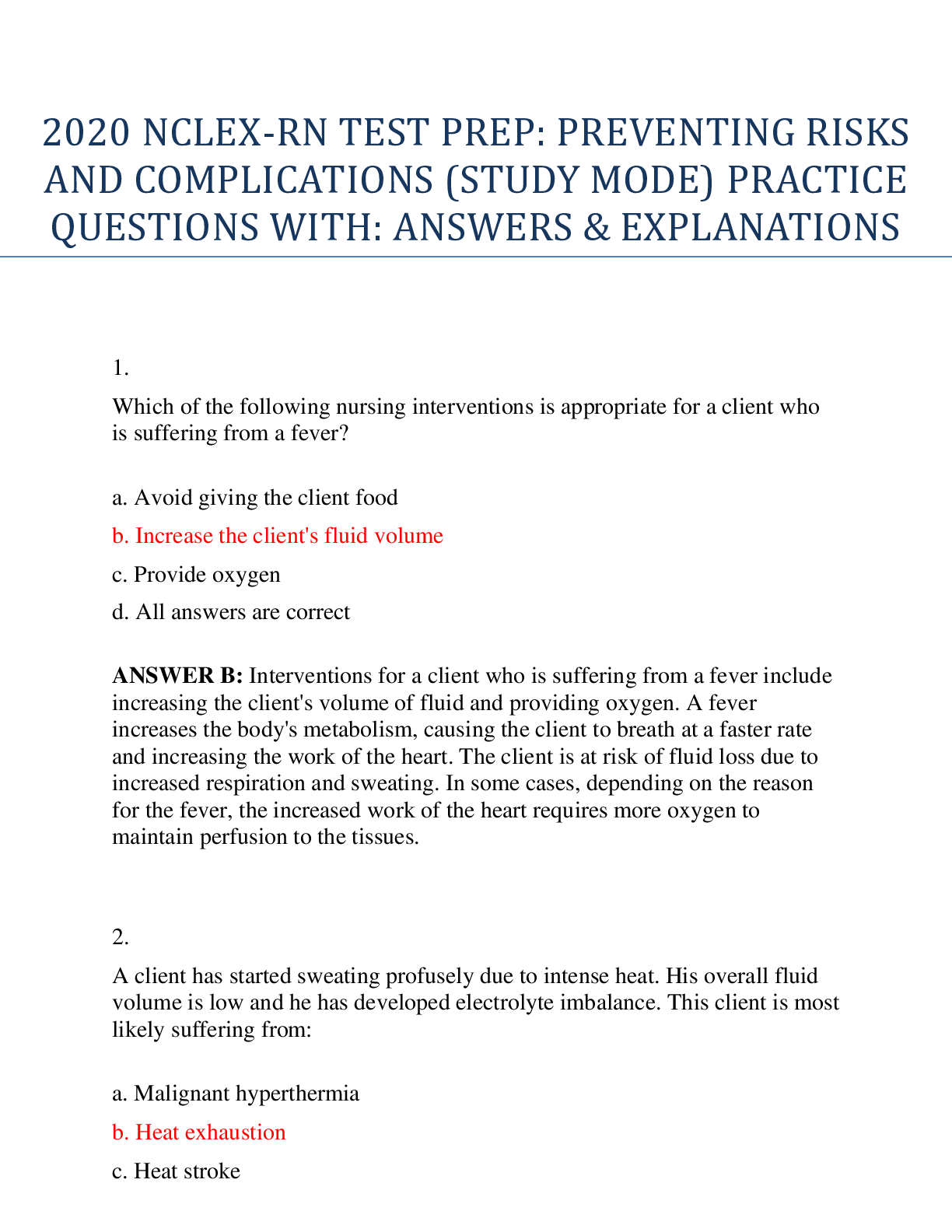
Buy this document to get the full access instantly
Instant Download Access after purchase
Add to cartInstant download
Reviews( 0 )
Document information
Connected school, study & course
About the document
Uploaded On
Jun 14, 2020
Number of pages
43
Written in
Additional information
This document has been written for:
Uploaded
Jun 14, 2020
Downloads
0
Views
112



